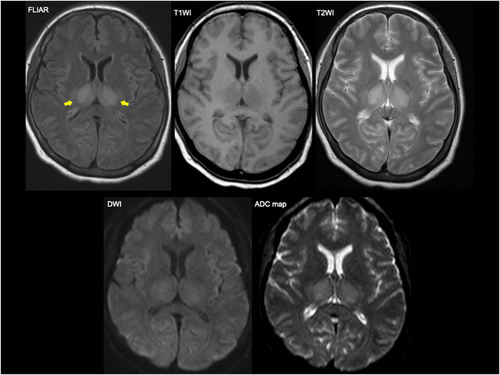Herpes simplex virus-induced acute necrotizing encephalopathy in an adult
A 39-year-old female was referred to our emergency center with a consciousness disorder that got worse by the hour after hospitalization at her local hospital for a urinary tract infection 5 days prior. She had no past medical history. Physical examination revealed the following: Glasgow Coma Scale, E2V2M6; blood pressure, 90/70 mm Hg; heart rate, 110 beats/min; respiratory rate, 30 breaths/min; and body temperature, 38.0°C. White blood cell count, lactate dehydrogenase levels, and c-reactive protein levels were 26,000/μL, 964 U/L, and 4.61 mg/dL, respectively. Only protein levels were elevated to 140 mg/dL in the cerebrospinal fluid. Magnetic resonance imaging revealed abnormal signals in bilateral thalami, which raised the suspicion of acute necrotizing encephalopathy (ANE) (Fig. 1). High-dose intravenous methylpredonisolone, immunoglobulins, and 500 mg 3 times/day acyclovir were administered. Herpes simplex virus (HSV)-specific antibodies were detected in the blood later. Despite intensive care, she succumbed to brain death 14 days after admission. ANE, which has a characteristic multifocal, symmetric, bilateral involvement of the thalami, is the fatal complication of pediatric viral infections.1-3 Macrophage activation and hypercytokinemia was considered to be in the pathogenesis of ANE. Influenza virus commonly causes adult ANE, making this the first report of HSV-induced ANE.3-5

FUNDING INFORMATION
No funding information provided.
DISCLOSURE
Approval of Research Protocol: Not applicable.
Registry and the Registration No. of the Study/Trial: Not applicable.
Informed Consent: Written informed consent was obtained from the patient for publication of this case report and accompanying images.
Conflict of Interest: All authors declare that they have no conflict of interest and the manuscript has not been previously published; the manuscript is not under consideration for publication elsewhere.




